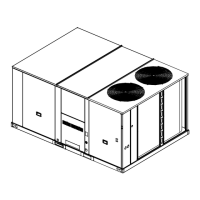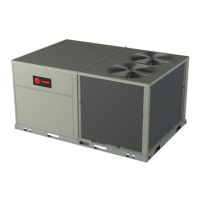Do you have a question about the Trane Foundation EAC180AD and is the answer not in the manual?
Brief notes and explanations regarding the unit's model designation and configuration options.
Definitions and explanations of safety advisories used throughout the manual to ensure user safety.
Discussion on man-made chemicals affecting the ozone layer and refrigerants.
Emphasizes the importance of responsible handling, reclaiming, and recycling of refrigerants.
Outlines company EHS policies for work activities and adherence to local regulations for safety.
Provides a brief description of the manual's content and its purpose for operation and maintenance.
Procedures for inspecting the unit upon arrival, checking nameplate data and for shipping damage.
Details safety precautions, especially regarding fiberglass wool exposure and proper PPE usage.
Provides immediate actions for eye and skin contact with dust or materials, and seeking medical attention.
Guidelines for storing the unit to prevent condensate formation in electrical compartments and motors.
Overview of the unit's factory testing, dehydration, and component features like direct-drive fans.
Explains basic input devices and their functions as they interface with unit features, referencing schematics.
Describes the function of the optional COF switch which disables the unit when condensate level rises.
Details the phase monitor module's function in protecting against phase loss, reversal, and unbalance.
Explains how discharge line thermostats and high-pressure controls protect the compressor by disabling its contactor.
Describes the optional Frostat™ control that prevents compressor operation or shuts it down if frost conditions occur.
Explains the device that monitors safety switch trips to prevent short cycling and protect the compressor.
Details various sensors like high-temperature sensors and thermostats, including their functions and setpoints.
Provides essential safety warnings and instructions for properly lifting and rigging the unit, including weight considerations.
A checklist of essential steps for successful unit installation, covering shipping, model verification, and site requirements.
Critical instructions and warnings regarding roof structure support, unit leveling, and anchoring methods.
Specific notes for installing horizontal units, including leveling and snow line considerations.
Recommendations for ductwork connections, including flexible connectors and weatherproofing outdoor ductwork.
Information on accessing and requirements for the unit's installed filters.
Guidelines for proper sizing, installation, and compliance of field-supplied power wiring to the unit.
Critical safety warning and requirements for field wiring and grounding of the main unit power supply.
Details on protecting electrical service from over current and sizing protection devices according to nameplate data.
Information on the 24-volt control power transformer, its accessories, and circuit breaker reset procedure.
Guidelines for AC control wiring, including conductor sizing, resistance limits, and conduit separation.
Explains how to measure and correct voltage imbalance to prevent motor overheating and failure.
Instructions for determining and correcting electrical phasing to ensure proper motor rotation and prevent damage.
Emphasizes powering the unit and energizing crankcase heaters before compressor starts to prevent premature failure.
A final checklist to ensure all components are correctly installed and ready for operation before start-up.
Details the importance of proper airflow and how to adjust fan speed for optimal system performance.
Step-by-step instructions for testing electromechanical controls by making specific thermostat wire connections.
Describes the sequence of operations for cooling and heating cycles using electromechanical controls.
Explains the operation of cooling, fan, and heating cycles using electromechanical controls and thermostat settings.
Details the function of the optional COF switch in preventing drain pan overflow and disabling the unit.
Describes how the Low Ambient Controller cycles the outdoor fan motor during low ambient temperatures.
Instructions to ensure proper protection for 10HP indoor fan motors by setting the overload dial.
Procedures for connecting service gauges, verifying compressor rotation, and checking pressures during start-up.
Steps to check heater stage operation by measuring amperage at the heater contactor.
Final checks before leaving the unit, including programming thermostat settings and ensuring panels are secured.
Procedure for adjusting fan belt tension using a belt tension gauge to ensure proper unit operation.
Routine checks including inspection of filters, drain pans, coils, and electrical connections.
Instructions for inspecting, cleaning, or replacing the unit's return air filters as needed.
Guidance on checking the condensate overflow switch float for free movement during maintenance.
Specific checks for the cooling season, including drain pans, coils, fan motors, and damper linkages.
Checks relevant to the heating season, such as inspecting filters, fan motors, and the electric heat system.
Procedures for cleaning condenser coils to maintain operating efficiency, with specific notes for microchannel coils.
A section for recording unit data, such as model number, serial number, and wiring diagram numbers, for future reference.
Guidance on diagnosing and resetting common failures like cooling failures, heat/cool lockouts, and condensate overflow.
This document outlines the installation, operation, and maintenance procedures for Trane Packaged Rooftop Air Conditioners, specifically the Foundation™ Electric/Electric models ranging from 15 to 22 tons, 50Hz. These units are designed to provide comfortable, energy-efficient indoor environments for commercial applications.
The Trane Packaged Rooftop Air Conditioners are self-contained, air-cooled systems designed for cooling and electric heating. Each unit is leak-tested, dehydrated, charged with refrigerant and compressor oil, and run-tested for proper control operation before shipment. They feature direct-drive, vertical discharge condenser fans with built-in thermal overload protection.
The units are equipped with electromechanical controls for managing cooling and heating cycles. In cooling mode, when the thermostat calls for cooling, the compressor contactors energize, starting the compressors and outdoor fan motors. If the first stage of cooling is insufficient, a second stage activates. For heating, when the thermostat calls for heat, electric heat contactors energize, providing staged heating as needed.
An optional Condensate Overflow Switch (COF) is available to prevent water overflow from the drain pan. If the condensate level reaches a trip point, the COF relay energizes, opening the 24VAC control circuit and disabling the unit, with a 3-minute delay timer to prevent immediate restart.
For low ambient operation, an optional Low Ambient Controller cycles the outdoor fan motor based on discharge pressure when outside air temperature is below 50°F, while the indoor fan motor continues to operate.
The Phase Monitor is a three-phase line monitor module that protects compressors from reverse rotation due to phase loss, phase reversal, or phase unbalance. It automatically resets from a fault condition. Discharge Line Thermostat Controls and high-pressure controls are wired in series to the Locking Safety Device (LSD), which disables the compressor contactor coil if these controls open, with an automatic lockout.
An optional Evaporator Frost Control (FOS) is mounted on the indoor coil. If this circuit is open before compressor start, the compressor will not operate. If it opens for 5 continuous seconds during operation, the compressor turns off immediately and cannot restart for a minimum of 3 minutes.
The Locking Safety Device with Anti-Short Cycle Timer monitors compressor safety switch trips to prevent short cycling and requires a manual reset after a fourth safety switch trip.
Optional sensors enhance functionality:
Proper installation is crucial for optimal performance. Units can be installed at ground level with concrete footings or on rooftops with a roof curb. Ductwork should be attached with watertight flexible connectors to minimize noise and prevent leaks. Non-factory penetrations through the unit's base are not permitted to maintain watertight integrity.
Before starting, it is essential to verify proper air flow, especially for units with belt-drive indoor fans, by adjusting the motor sheave. The unit's crankcase heaters must be energized for at least 8 hours before compressor start-up to prevent oil foaming and potential compressor damage.
Electrical phasing for three-phase motors must be checked to ensure correct rotation of compressors and supply fan motors. Incorrect phasing can lead to motor overheating and failure. Voltage imbalance should also be checked, with a maximum allowable imbalance of 2 percent to prevent motor winding damage.
The unit ships with 2-inch filters, which are accessible by removing the filter access panel. The unit should not be operated without filters.
Regular maintenance is vital for ensuring trouble-free operation and extending the life of the equipment. This includes periodic inspections and servicing.
| Model | EAC180AD |
|---|---|
| Type | Air Conditioner |
| Refrigerant | R-410A |
| Voltage | 208/230V |
| Phase | 1 |
| Cooling Capacity | 18000 BTU |












